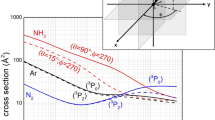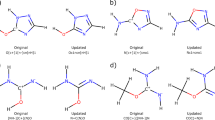Abstract
Any long-lived chemical structure in solution is subject to statistical energy equilibration, so the history of any specific structure does not affect its subsequent reactions. This is not true for very short-lived intermediates because energy equilibration takes time. Here, this idea is applied to achieve the ‘energy labelling’ of a reactive intermediate. The selectivity of the ring-opening α-cleavage reaction of the 1-methylcyclobutoxy radical is found here to vary broadly depending on how the radical was formed. Reactions that provide little excess energy to the intermediate lead to a high selectivity in the subsequent cleavage (measured as a kinetic isotope effect), whereas reactions that provide more excess energy to the intermediate exhibit a lower selectivity. Accounting for the expected excess energy allows the prediction of the observed product ratios and, in turn, the product ratios can be used to determine the energy present in an intermediate.
This is a preview of subscription content, access via your institution
Access options
Access Nature and 54 other Nature Portfolio journals
Get Nature+, our best-value online-access subscription
$29.99 / 30 days
cancel any time
Subscribe to this journal
Receive 12 print issues and online access
$259.00 per year
only $21.58 per issue
Buy this article
- Purchase on Springer Link
- Instant access to full article PDF
Prices may be subject to local taxes which are calculated during checkout




Similar content being viewed by others
References
Griesbeck, A. G., Mauder, H. & Stadtmüller, S. Intersystem crossing in triplet 1,4-biradicals: conformational memory effects on the stereoselectivity of photocycloaddition reactions. Acc. Chem. Res. 27, 70–75 (1994).
Alezra, V. & Kawabata, T. Recent progress in memory of chirality (MOC): an advanced chiral pool. Synthesis 48, 2997–3016 (2016).
Hembury, G. A., Borovkov, V. V. & Inoue, Y. Chirality-sensing supramolecular systems. Chem. Rev. 108, 1–73 (2008).
Berson, J. A. Memory effects and stereochemistry in multiple carbonium ion rearrangements. Angew. Chem. Int. Ed. 10, 779–791 (1968).
Ghigo, G., Maranzana, A. & Tonachini, G. Memory effects in carbocation rearrangements: structural and dynamic study of the norborn-2-en-7-ylmethyl-X solvolysis case. J. Org. Chem. 78, 9041–9050 (2013).
Bunker, D. L. & Hase, W. L. On non-RRKM unimolecular kinetics: molecules in general, and CH3NC in particular. J. Chem. Phys. 59, 4621–4632 (1973).
Elles, C. G., Cox, J. & Crim, F. F. Vibrational relaxation of CH3I in the gas phase and in solution. J. Chem. Phys. 120, 6973–6979 (2004).
Assmann, J. et al. Real-time observation of intra- and intermolecular vibrational energy flow of selectively excited alkyl iodides in solution: the effect of chemical substitution. J. Phys. Chem. A 106, 5197–5201 (2002).
Sibert, E. L. III, Rames, S. G. & Gulmen, T. S. Vibrational relaxation of OH and CH fundamentals of polar and nonpolar molecules in the condensed phase. J. Phys. Chem. A 112, 11291–11305 (2008).
Rynbrandt, J. D. & Rabinovich, B. S. Intramolecular energy relaxation. nonrandom decomposition of hexafluorobicyclopropyl. J. Phys. Chem. 75, 2164–2171 (1971).
Collins, P., Kramer, Z. C., Carpenter, B. K., Ezra, G. S. & Wiggins, S. Nonstatistical dynamics on the caldera. J. Chem. Phys. 141, 034111 (2014).
Kurouchi, H., Andujar-De Sanctis, I. L. & Singleton, D. A. Controlling selectivity by controlling energy partitioning in a thermal reaction in solution. J. Am. Chem. Soc. 138, 14534–14537 (2016).
Quijano, L. M. M. & Singleton, D. A. Competition between reaction and intramolecular energy redistribution in solution: observation and nature of nonstatistical dynamics in the ozonolysis of vinyl ethers. J. Am. Chem. Soc. 133, 13824–13827 (2011).
Jenks, W. S., Gregory, D. D., Guo, Y., Lee, W. & Tetzlaff, T. in Organic Photochemistry (eds Ramamurthy, V. & Schanze, K. S.) 48–50 (Marcel Dekker, 1997).
Gregory, D. D. & Jenks, W. S. Thermochemistry of sulfenic esters (RSOR′): not just another pretty peroxide. J. Org. Chem. 63, 3859–3865 (1998).
Ollivier, C. & Renaud, P. Organoboranes as a source of radicals. Chem. Rev. 101, 3415–3434 (2001).
Singleton, D. A. & Szymanski, M. J. Simultaneous determination of intermolecular and intramolecular 13C and 2H kinetic isotope effects at natural abundance. J. Am. Chem. Soc. 121, 9455–9456 (1999).
Singleton, D. A. & Schulmeier, B. E. Evidence for a concerted mechanism in a palladium trimethylenemethane cycloaddition. J. Am. Chem. Soc. 121, 9313–9317 (1999).
Gonzalez-James, O. M. et al. Experimental evidence for heavy-atom tunneling in the ring-opening of cyclopropylcarbinyl radical from intramolecular 12C/13C kinetic isotope effects. J. Am. Chem. Soc. 132, 12548–12549 (2010).
Zheng, J. et al. GAUSSRATE, version 2009-A (University of Minnesota, 2010).
Zheng, J. et al. POLYRATE–version 2010 (University of Minnesota, 2010).
Sun, L., Park, K., Song, K., Setser, D. W. & Hase, W. L. Use of a single trajectory to study product energy partitioning in unimolecular dissociation: mass effects for halogenated alkanes. J. Chem. Phys. 124, 064313 (2006).
Pasto, D. J., Cottard, F. & Horgan, S. Self-induced, photochemical, singlet-oxygen oxidation of 4-nitrobenzenesulfenates to 4-nitrobenzenesulfinates. J. Org. Chem. 58, 4110–4112 (1993).
Busch, G. E. & Wilson, K. R. Triatomic photofragment spectra. I. Energy partitioning in NO2 photodissociation. J. Chem. Phys. 56, 3626–3638 (1972).
Hare, S. R., Pemberton, R. P. & Tantillo, D. J. Navigating past a fork in the road: carbocation–π interactions can manipulate dynamic behavior of reactions facing post-transition-state bifurcations. J. Am. Chem. Soc. 139, 7485–7493 (2017).
Spezia, R., Martinez-Nunez, E., Vasquez, S. & Hase, W. L. Theoretical and computational studies of non-equilibrium and non-statistical dynamics in the gas phase, in the condensed phase and at interfaces. Phil. Trans. R. Soc. A 375, 20170035 (2017).
Mikosch, J. et al. Imaging nucleophilic substitution dynamics. Science 319, 183–186 (2008).
Orlando, J. J. & Tyndall, G. S. Oxidation mechanisms for ethyl chloride and ethyl bromide under atmospheric conditions. J. Phys. Chem. A 106, 312–319 (2002).
Acknowledgements
We thank the National Institutes of Health (grant GM-45617) for financial support. H.K. thanks the Japan Society for the Promotion of Science for a Postdoctoral Fellowship for Research Abroad. We thank J. Martin for a preliminary study of the synthesis and reaction of 9.
Author information
Authors and Affiliations
Contributions
H.K. carried out all the experimental work and most of the computations, and chose the specific systems studied. Both authors analysed the results. D.A.S. conceived the general idea and wrote most of the manuscript.
Corresponding author
Ethics declarations
Competing interests
The authors declare no competing financial interests.
Supplementary information
Supplementary information
Supplementary information (PDF 2327 kb)
Rights and permissions
About this article
Cite this article
Kurouchi, H., Singleton, D. Labelling and determination of the energy in reactive intermediates in solution enabled by energy-dependent reaction selectivity. Nature Chem 10, 237–241 (2018). https://doi.org/10.1038/nchem.2907
Received:
Accepted:
Published:
Issue Date:
DOI: https://doi.org/10.1038/nchem.2907
This article is cited by
-
Stable chaos and delayed onset of statisticality in unimolecular dissociation reactions
Communications Chemistry (2020)
-
Unusual KIE and dynamics effects in the Fe-catalyzed hetero-Diels-Alder reaction of unactivated aldehydes and dienes
Nature Communications (2020)



